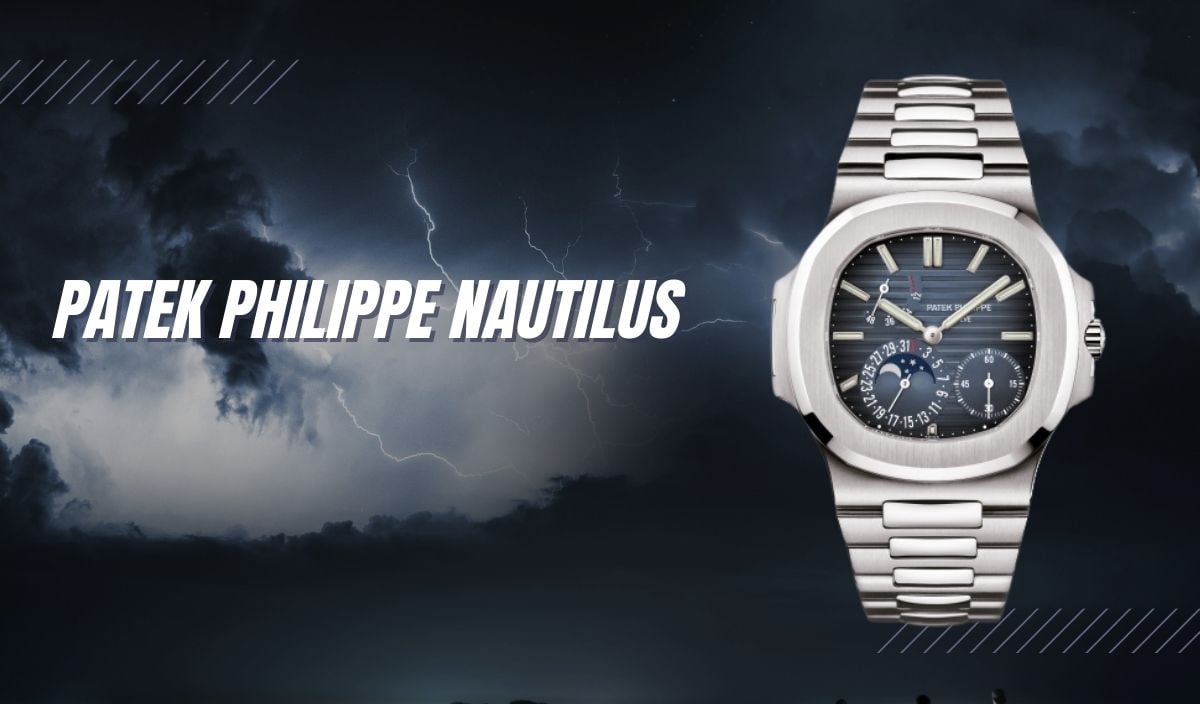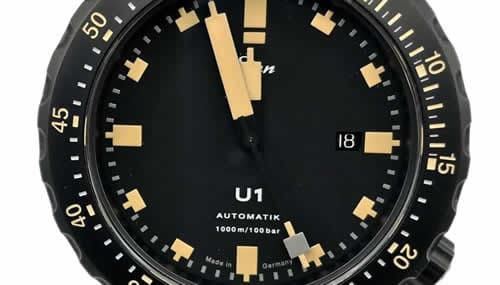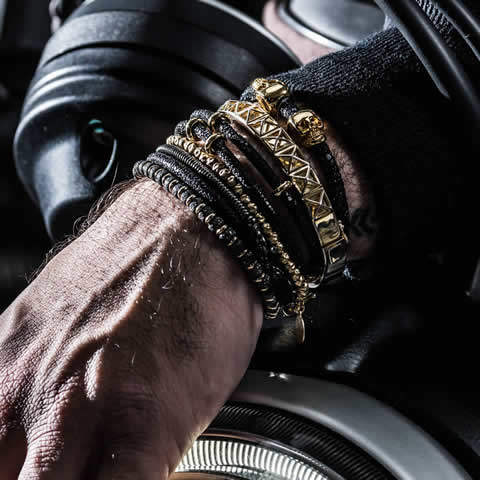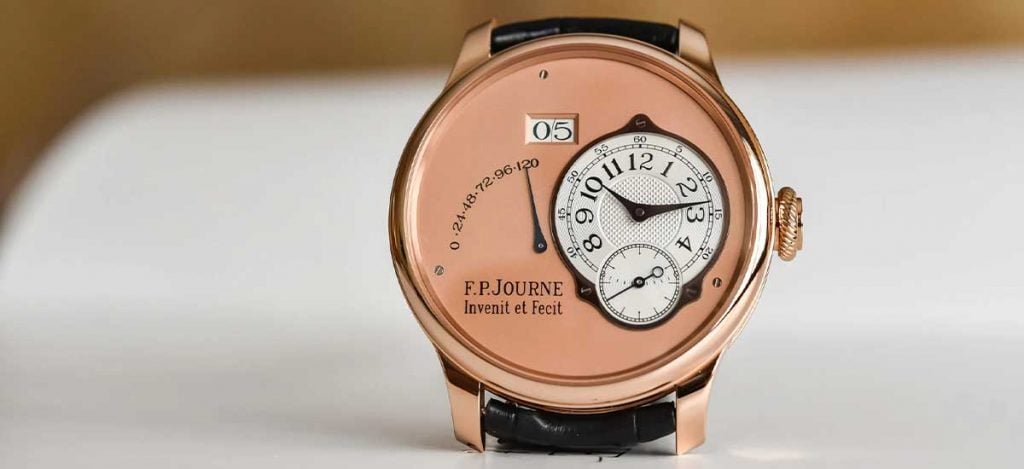
If ‘Nautilus’ is the first word that comes to mind when you hear Patek Philippe, join the club. For several years now, the iconic luxury sports timepiece from the 70s has been the ultimate grail watch for nearly every ambitious individual.
But before we put on our detective hats to figure out why exactly the Nautilus, of all Patek Philippe models, is more desirable to the high-end collector than a chewy treat is to my cat, we first need to learn about the brand itself.
History of the Patek Philippe Nautilus

Founded in 1839, Patek Philippe is one of the last family-owned, independent watchmakers in Geneva, with an uninterrupted watchmaking history of nearly two centuries. Being one of the oldest Swiss watch manufacturers, the brand has made significant contributions to the modern world of horology.
Patek Philippe is considered the master of ‘Supercomplications’, a reputation the brand acquired by being one of the earliest pioneers of both the Perpetual Calendar mechanism and the Annual Calendar on a wristwatch. And in 1976, the brand released its first luxury sports watch, which is still considered the upper echelon of luxury in the watch world.
Why Was the Nautilus Created?
The quartz crisis of the 70s made it crucial for the Swiss watch industry’s survival to get on board with the revolutionary quartz technology. This was due to the fact that a quartz movement proved not only more affordable to produce, but also much more accurate and robust than the comparatively-delicate mechanical movement.
The Swiss luxury watch brands had a difficult choice: either change their long-standing approach to masterfully-crafted mechanical watchmaking or take a massive risk by doing something that hadn’t been done before (except by AP). But just like Audemars Piguet, Patek Philippe went with the second option.
At a time when luxury watches were constructed exclusively with precious metals, the brand introduced a luxury timepiece made entirely of stainless steel, a move that was initially seen as an absurd oxymoron. Following AP’s footsteps, Patek hired the young Gerald Genta to design this relatively new concept. And thus, the iconic Nautilus was born.
Design Inspiration of the Nautilus

It’s true that a designer’s mind never rests. As the story goes, while dining with Henry and Philipe Sterns from Patek Philippe, Genta brainstormed and produced a napkin sketch. The sketch of this watch featured a case design inspired by the porthole window of a transatlantic liner and ‘ears’ influenced by the hinges of those portholes.
The five-minute doodle on this napkin would go on to be the blueprint of one of the most important watches the brand ever produced. Apart from the iconic case and dial, the Nautilus would also feature an integrated bracelet, a trending feature at the time.
Although the collector community loves to compare the Nautilus with AP’s Royal Oak, these two were created with different inspirations behind their iconic designs. While the Royal Oak has a ‘brutalist’ design with an industrial look, the Nautilus is seen as the more refined of the two, with a rounded octagonal bezel.
Facts to Know About the Nautilus
Design
All the Nautilus references come in a rounded case shape, with the iconic ‘ears’ on two sides of the case. The watches are constructed with various case materials (such as stainless steel, gold, and two-tone), dial configurations, movements, bracelet options, and complications.
While some models feature a monobloc case construction, most modern variants are manufactured using a 3-part case construction (although, the latest ref-5811/1A has returned to an upgraded version of the monobloc case).
Complications
The Nautilus wouldn’t be a Patek Philippe without the brand showing off some of its technical superiority in its most sought-after collection. Apart from the standard Time and Date featured in all Nautilus references, you’ll also find numerous complications such as Chronograph, Moonphase, Annual Calendar, and Perpetual Calendar on the brand’s more sophisticated models.
Water Resistance
Designed as a luxury sports watch with water resistance ranging from 60m to 120m, the Nautilus is well-equipped with features that position it as an excellent, versatile timepiece for daily activities.
In today’s context, I consider it more of a luxury everyday-style watch than a true sports watch. Typically, the dressier and more complicated models, like the Grand Complication, will provide lesser water resistance than the regular time/date models.
Price
Pricing any Nautilus can get tricky, as the difference between the retail and the secondary market price is colossal. The main reason for this is that the brand’s supply cannot keep up with the demand, causing a waitlist system to be implemented that many collectors may not feel keen about. Thus, it’s not ordinary to see a Nautilus sell several times over its retail price in the gray market.
Notable Patek Philippe Nautilus Models You Should Know
By no means is this a definitive list of all Patek Nautilus models. But I chose these fifteen models to showcase the different styles, materials, dial configurations, movements, and functions that can be found within the Nautilus lineup.
I also grouped these models into three categories for the sake of an easy understanding of the numerous variants that can be found within the Nautilus family. These categories are:
- Classic Nautilus (Time & Date)
- Complications
- Ladies Collection
Classic Nautilus
1. Nautilus 3700/1A

The Patek Philippe Nautilus 3700/1A, released in 1976, was an elegant, yet sporty luxury watch, produced by a brand mostly known for manufacturing the world’s best complicated timepieces. The timepiece was constructed from a 42mm monobloc stainless steel case with a slim height of 7.6mm and a straight, integrated bracelet with polished center links.
The monobloc case was a patented design that enabled the watch to have 120m of water resistance, thanks to a gasket underneath its bezel. Apart from the iconic case design, the dark blue dial with horizontal grooved lines popped as the only contrasting element on a monochromatic timepiece.
The ultra-thin movement inside this watch was the caliber 28-255 C. Although this movement was supplied by Jaeger-LeCoultre, it was modified by Patek Philippe and featured Patek’s proprietary Gyromax balance wheel.
This movement ticked at a beat frequency of 19,800 VPH and had a 40-hour power reserve. The 3700/1A is still considered by many as the most important Nautilus, as it paved the way for future variants. Not to mention helping the brand stay relevant during difficult times.
The watch retailed at approximately $3,100 at the time of its release.
2. Nautilus 5711/1A-010

While this wasn’t the first Nautilus, something about the 5711/1A made it an absolute legend within the high-end collector’s sphere. Released during the 30th anniversary of the Nautilus, this relatively-uncomplicated watch somehow became more desirable than most of the brand’s notable offerings.
While closely resembling the 3700/1A in its dial color, there were some significant differences between the two. Compared to the original ‘Jumbo’, the 5711 came in a wrist-friendly size of 40mm stainless steel case, with a case height of 8.3mm and 120m of water resistance.
Housed within the case was the in-house caliber 324 S C, which offered an improved power reserve of 45 hours while beating at a higher frequency of 28,800 vibrations per hour, but also featured a 24k gold rotor with Côtes de Genève decoration.
Not to mention that technological innovations, such as the Gyromax balance wheel and the Spiromax balance spring, meant that the performance of the 5711 was superior to that of its predecessor.
The 5711/1A retailed at approximately $25,000 at the time of its release.
3. Nautilus 5711/1A-014

The Patek Philippe Nautilus 5711/1A-014 came out not long after the official discontinuation of the 5711/1A. And although it lived a surprisingly short production run, it was successful in boosting the trend of green dials on wristwatches.
Unfortunately for die-hard fans unable to acquire this model during its tremendously fruitful period, Patek Philippe no longer produces this reference, along with any other 5711 model. The watch came in a 40mm stainless steel case, with 8.3mm thickness and a green dial unique to the Nautilus family, making this a truly rare timepiece.
The movement used was Patek’s latest in-house Caliber 26-330 S C, also utilized in the newer Nautilus 5811 model. This updated movement, replacing the 324 S C, beats at 28,800 VPH with up to 45 hours of power reserve and features both the Gyromax balance wheel and Spiromax balance spring.
Although the watch retailed at approximately $35,000, one factory-sealed piece was sold at an auction in Monaco for a dizzying price of $470,000.
4. Nautilus 5711/1A-018

Yes, you knew this was coming! If you thought the green Nautilus was a shock to the watch world, its hype was nothing compared to the ‘Tiffany Blue’ reference, released by the end of 2021.
As jaw-dropping as it was, the $6.5 million that one of these sold for at Philip’s auction wasn’t too surprising, considering that this was not just the final rendition of the legendary 5711, but was also a double-signed dial with an extremely limited release of just 170 pieces. It doesn’t get any rarer than this!
The watch was presented in a 40mm steel case, with a thickness of 8.3mm and 120m of water resistance. The manufacture caliber 26-330 S C could be seen through the exhibition caseback, along with a few other details that were exclusive to this piece. These included the sapphire caseback text highlighting the partnership between the two brands.
This 170th Anniversary model, commemorating the 170 years of partnership between Tiffany and Patek, retailed at $53,000 and was exclusively available at the Tiffany & Co. boutiques in New York, San Francisco, and Beverly Hills.
5. Nautilus 5811/1G-001

After the Nautilus 5711/1A was officially discontinued, the brand released the 5811/1G-001 as the ‘new and improved’ flagship Nautilus as a replacement for the 5711.
This new 2022 model is constructed of a two-part, 41mm white gold case instead of the smaller stainless steel case used in the 5711. However, it maintains a case height of 8.3mm and 120m water resistance. The 5811/1G fashions a sunburst blue-black dial with a centric gradient effect and white gold applied indices and handset.
Additionally, the watch features an improved bracelet with a patented fold-over clasp with micro-adjustments, enhancing the wearing experience. The decorated movement, displayed through the sapphire caseback, is the latest manufacture caliber 26-330 S C, which beats at 28,800 VPH, giving the watch up to 45 hours of power reserve and smooth sweeping seconds hand.
Considering the never-ending demand, along with the updated design and specifications, the $69,790 retail price for this watch doesn’t seem unreasonable for what’s being offered in terms of improved technical specifications and design.
6. Nautilus 5711/1P-011

In 2016, during the 40th Anniversary of the Nautilus, Patek released a 5711 made entirely of platinum, and the watch community’s reaction was… mixed.
While, unsurprisingly, several ecstatic collectors competed to get one in their collection, others could not get over the bold “40 1976-2016” text on the dark blue dial (although it’s said to be much more subtle in the flesh than what the press photos indicate).
The 40mm case was made up of solid platinum 950, had a thickness of 8.3mm, and water resistance of 120m, making it another elegant yet sports-capable timepiece.
The sunburst gradient blue dial, slightly brighter than the standard 5711/1A, featured baguette diamond indices, adding to the platinum watch’s luxurious feel. Similar to the standard 5711, this watch featured the beautifully decorated in-house caliber 324 S C and provided 40 hours of power reserve while beating at 28,800 VPH.
With subtle details that separated it from the standard steel Nautilus, along with being limited to only 700 pieces and a stomach-churning retail price of approximately $113,000 (at the time of release), this watch was a true understated ‘flex’ to own.
7. Nautilus 5719/10G-010

There aren’t many watches that have the potential to make the standard 5711 look like a poor man’s Patek. However, the fully diamond-covered 5719/10G-010 does just that!
The watch comes in a 40mm white gold case, a slightly thicker case height of 8.7mm, 120m of water resistance, and the automatic caliber 26-330 S C beating inside. The movement provides 28,800 vibrations per hour (4Hz) and 45 hours of power reserve.
A total of 1,343 flawless diamonds are set by hand on this timepiece (strictly complying with Patek Philippe’s Seal’s stringent requirements). Just to give an idea, the breakdown of these gemstones is as follows:
255 diamonds and 3 baguette diamonds on the 18k gold dial.
100 diamonds and 32 baguette diamonds on the case
803 diamonds and 150 baguette diamonds on the bracelet.
While the Tiffany Blue Nautilus had its secondary price driven up by demand, this diamond-encrusted timepiece is the epitome of luxury, retailing at a whopping price of approximately $453,600.
Complications
8. Nautilus 5726A-001

As seen by now, the Nautilus is generally known for its three-handed luxury sports watch with an integrated bracelet. However, the reference 5726A-001 gives us a more complicated watch, this time with an alligator leather strap.
The watch comes in a 40.5mm stainless steel case with a thickness of 11.3mm, water resistance of 120m, and sapphire crystals covering both the dial and the caseback. Through the exhibition caseback, you can view the decorated Patek Philippe Caliber 324 S QA LU 24H/303.
This relatively long movement reference number is attributed to the complications that the watch features, which include the Annual Calendar and Moonphase, along with the Day, Date, Month, and 24-hour display.
This movement beats at 28,800 VPH and maintains a power reserve of up to 45 hours. The sunray gradient black dial with the signature embossed horizontal groove lines, combined with the black leather strap and the gorgeous blue Moonphase at the lower center, make this model a hopeless romantic’s ideal grail timepiece.
The Nautilus 5726A-001 retails for approximately $49,090.
9. Nautilus 5980/1AR-001

It’s understandable when watch brands avoid dabbling with two-tone case materials, as these often lead to a divided fanbase. It’s always when you plan to bring back something that was ‘cool’ in the 80s. But in 2013, Patek Philippe released one of the most desirable two-tone luxury sports watches ever made.
The Nautilus 5980/1AR-001 comes in a 40.5mm two-tone case, with a mixture of stainless-steel and 18k rose gold case. The larger case height of 12.2mm is attributed to the automatic caliber CH 28-520 C, featuring a column-wheeled flyback chronograph and a date indicator. This movement gives the watch a higher power reserve than the standard three-hand Nautilus, allowing it to run for up to 55 hours at a beat frequency of 28,800 VPH.
By expertly combining highly elegant and sporty elements (and not resulting in an accidental creation of ‘Frankenstein’s monster’), the brand did not just create a gorgeous contemporary timepiece but also a truly versatile one!
With up to 120m of water resistance, a solid rose gold screw-down crown, and a sapphire caseback, the watch retails at approximately $75,700.
10. Nautilus 5980R-001

The Nautilus 5980R-001 is identical to the previously mentioned ref. 5980/1AR in terms of the technical features, but it comes with different case and bracelet configurations, making this model look and feel entirely distinct.
The 40.5mm case is made of rose gold and displays a gradient brown dial with darker tones on the periphery. Similar to the 5980/1AR, this model features matching rose gold applied indices with lume, along with a rose gold handset.
However, this reference appears sportier, thanks to the white and red accents on the subdial above 6 o’clock that features a co-axial chrono counter. And the fact that the chronograph pushers on either side of the right ‘ear’ hardly stand out makes this model maintain the easily recognizable rounded silhouette of the Nautilus.
The movement housed inside the brushed and polished rose gold case is the manufacture caliber CH 28-520 C, featuring Patek Philippe’s seal-worthy hand finishing and a 55-hour power reserve.
This Nautilus 5980R-001 comes at a retail price of approx. $73,330.
11. Nautilus 5712/1R-001

Unlike most Nautilus references that maintain symmetry with their dials, the 5712/1R-001 differentiates itself by presenting the most playful and equally daring dial configuration.
The gradient-brown dial shows off a gorgeous Moonphase and date indicator on the bottom left, a subdial with small seconds on the bottom right, and a power reserve indicator on the top left corner, rendering this as one of the busiest dials on a Patek Nautilus.
Part of the latest release within the Nautilus family, this variant comes in a fully rose gold case and integrated bracelet, measuring at 40mm case diameter and a slim height of only 8.52mm. Inside the case is the automatic Caliber 240 PS IRM C LU, which provides the wearer a slower beat frequency of 21,600 VPH, but a slightly extended power reserve of up to 48 hours.
Considering that this reference features just 60m of water resistance, you wouldn’t take this as a do-it-all sports watch but rather as an exquisite dress or everyday style watch.
The retail price of the reference 5712/1R-001 is approximately $82,800.
12. Nautilus 5740/1G-001

Patek Philippe pulled out all of its guns with the release of its most complicated Nautilus in 2018, the reference 5740/1G-001. The watch is presented in a 40mm white gold case, with an 8.42mm thickness, a tapered integrated gold bracelet, sapphire crystal covering both the dial and the see-through caseback, and a water resistance of 60m.
Powering the first Grand Complication model within the Nautilus lineup is the Patek Philippe Caliber 240 Q, ticking at a beat frequency of 28,800 VPH and having a power reserve of 45 hours. The blue dial on this appears much brighter than a 5711’s darker gradient dial.
It displays three subdials featuring various functions: Day/Night Indication, Date, Leap Year, Month, Perpetual Calendar, and a Moonphase. The fact that Patek incorporated a Grand Complication in such an ultra-thin case truly showcases the unbeatable watchmaking strength of the brand.
This is also the most expensive Nautilus model sold at retail for a staggering price of approx. $145,480.
Ladies Collection
13. Nautilus 7118/1A-010

It’s often construed by the enthusiast community that the majority of watch brands don’t cater to women’s watches as well as men’s. And while this can be debated, most can’t deny the pursuit of perfection from Patek Philippe when looking at the ladies’ collection, like this Nautilus 7118/1A-010.
This watch comes in a 35.2mm stainless steel case, a case thickness of 8.62mm, and a water resistance of 60m. With a combination of silvery opaline and gray dial featuring a wave motif instead of the strictly linear lines of the larger counterparts, the 7118/1A is one of the more subdued models within the ladies’ lineup.
Housed inside the case is the automatic Caliber 324 S C, beating at 28,800 VPH and providing a maximum power reserve of 45 hours. Apart from the pattern, all of the minor details on the dial, including the hands, applied indices, and the date window placement, make this reference boast an original design whilst maintaining the unmistakable design DNA of the Nautilus.
With a retail price of approximately $30,750, this is a strong contender as an elegant yet discreet, everyday-style luxury timepiece.
14. Nautilus 7010/1R-012

The Patek Philippe reference 7010/1R-012 is by far the most compact offering within the Nautilus collection, coming in at just 32mm, with a case height of 6.9mm and a water resistance of 60m.
The model features a solid rose gold case, an integrated bracelet, a two-tone golden/brown wave dial, and 45 flawless diamonds individually set on the gold bezel.
Powering the timepiece is an in-house quartz Caliber E23-250 S C.. Unlike the mass-produced quartz calibers found in entry-level watches, this movement transcends nearly all quartz calibers in terms of its finishing, performance, and overall attention to detail.
Protected behind the solid caseback, the Caliber E23-250 S C beats at a quartz frequency of 32,768 Hz and has a battery life of 3 years. And although this model can be found in a few other configurations, including different dial and strap options, I found the 7010/1R-012 to be a well-balanced pick that exudes a feel of both elegance and style.
This reference retails at approximately $52,040
15. Nautilus 7118/1300R-001

The Patek Nautilus 7118/1300R-001 can be seen as the polar opposite of the relatively minimal 7118/1A-010 discussed previously. The rose-gilt ‘waves’ motif dial features 11 reddish-brown spessartite gemstones as hour markers and 68 baguette-cut spessartites on the bezel.
And if this is the first time you see these gemstones on a watch, it shouldn’t be surprising considering how rare these stones are. The solid rose gold case measures 32mm, with a case thickness of 8.62mm, and comes with 60m of water resistance.
Housed inside the case is the Patek Philippe automatic Caliber 324 S C, coming in with 45 hours of power reserve and a smooth sweeping seconds hand thanks to the 28,800 VPH beat frequency. What I find truly fascinating about this reference is how the gemstones constantly play with light to create ever-changing shades of red, gold, and brown.
The contrast between these darker cognac-colored gems against the much lighter case and dial makes the design of this watch a breathtaking hybrid of classic and contemporary. It’s unique but not too flashy, and I absolutely adore that about this fusion.
The 7118/1300R-001 retails at approximately $82,000.
Final Thoughts
It’s hard to believe that Patek Philippe had anticipated the level of success one of their riskiest releases would garner over several decades. It’s almost poetic to see how such an attempt at the brand’s survival resulted in the creation of a timeless legend.
No matter what case materials, dial colors, complications, or bracelet options are featured on the various Nautilus references, the iconic silhouette of Patek Philippe’s most successful timepiece remains uncompromised.

















